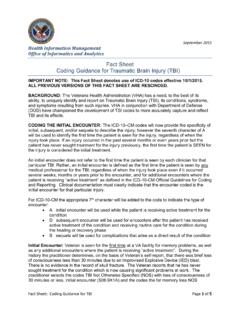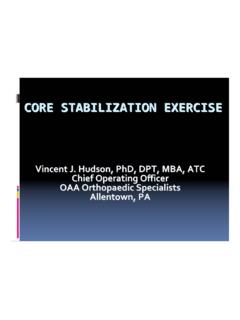Transcription of Acronyms - Medical Record Terminology
1 Commonly Used Medical Acronyms and Terminology10/5 Absent Strength- no observable movement1/5 Trace Strength- able to activate the muscle group, movement may or may not occur2/5 Poor Strength- able to move with gravity eliminated or some movement against gravity3/5 Fair Strength- able to move against gravity but cannot accept resistance to movement4/5 Good Strength- able to move against gravity and accept some resistance5/5 Normal Strength- able to move against gravity and accept full resistanceincreaseddecreasedAAssistA+Ox3 Alert and Oriented to person, place and timeABDuctionMovement AWAY from the middleAbsent Strength0/5- no observable deviceADDuctionMovement TOWARD the middleADLA ctivities of daily livingAEAA bove Elbow AmputeeAFOA nkle-Foot-Orthosis (brace)AKAA bove Knee AmputeeALSA myotrophic Lateral SclerosisAmbAmbulationAnteriorFront of the bodyAROMA ctive range of motionASIAA merican spinal Cord AssociationASISA nterior Superior Iliac Spine- a bony landmark on the pelvisBBilateral or BothBEAB elow Elbow AmputeeBIDtwice a dayBKAB elow Knee AmputeeBLEB ilateral (or Both)
2 Lower ExtremitiesBOSBase of SupportBPBlood PressureBSBowel Sounds or Breath SoundsBUEB ilateral (or Both) Upper Extremitiescwithc/ocomplains ofCADC oronary Artery DiseaseCGAC ontact Guard Assistance (touching)CHFC ongestive Heart FailureCOGC enter of gravityCOPDC hronic Obstructive Pulmonary DiseaseCPCerebral PalsyCTAC lear to Auscultation (lungs)CVAC erbral Vascular Accident (stroke)DDependentd/cdischargeDependent BalanceUnable to move within the base of support, full external support requiredDistalAway from the trunk (ie; hands and feet)DMDiabetes MellitusDorsiflexionFlexion of the ankleDxDiagnosisDyspneaShortness of breathELRE levating leg restEtOHAlcoholExtensionStraightening of a limbFair BalanceAble to move within the base of support and accept minimal to no balance challengesFair Strength3/5- able to move against gravity but cannot accept resistance to movementFIM score of 0 The activity does not occurFIM score of 1 Total Assistance-The patient expends less than 25% of the effortCommonly Used Medical Acronyms and Terminology2 FIM score of 2 Maximal Assistance- The patient expends 25% - 49% of the effortFIM score of 3 Moderate Assistance.
3 The patient expends 50% - 75% of the effortFIM score of 44- The patient expends more than 75% of the effortFIM score of 5 Supervision- Standby, cueing or coaxing, without physical contactFIM score of 6 Modified Independence- The patient uses an adaptive or assistive deviceFIM score of 7 Complete IndependenceFlexionBending of a limbFWWF ront wheeled walker or Four wheeled walkerGood BalanceAble to move outside the base of support and accept mild balance challengesGood Strength4/5- able to move against gravity and accept some resistanceh/ohistory ofHTNH ypertension (high blood pressure)HxHistoryIIndependentIADLI nstrumental avtivities of daily livingInferiorToward the footKAFOKnee-Ankle-Foot Orthosis (brace)LLeftLateralFurther from the midline of the bodyLELower ExtremityLLELeft Lower ExtremityLOBLoss of balanceLUELeft Upper ExtremityMAXM aximal assistanceMaximal Assistance2- The patient expends 25% - 49% of the effortMDMuscular DystrophyMedialNearer to the midline of the bodyMIMyocardial Infarction (heart attack)MINM inimal assistanceMinimal Assistance4- The patient expends more than 75% of the effortMMTM anual muscle (strength)
4 TestMODM oderate assistanceModerate Assistance3- The patient expends 50% - 75% of the effortMOD IModified independentMSMultiple SclerosisMRADLM obility related activities of daily livingMVAM otor vehicle accidentMWCM anual wheelchairNIIDMNon-Insulin Dependent Diabetes MellitusNKANo known allergiesNormal BalanceAble to move outside the base of support and accept full balance challengesNormal Strength5/5- able to move against gravity and accept full resistanceOAOsteoarthritisOIOsteogenesis ImperfectaPADP eripheral Artery Disease (same as PVD)PCAP ersonal Care AssistantPlantarflexionExtension of the ankle (pointing the toe)PMDP ower mobility devicePoor BalanceAble to move within the base of support with the assistance of external support (holding on)Poor Strength2/5- able to move with gravity eliminated or some movement against gravityPosteriorRear of the bodyPOVP ower operated vehicle (scooter)pptPosterior Pelvic Tilt (slouched sitting posture)PRNAs neededPROMP assive range of motionProximalNear the trunk (upper arm, thigh) Vascular Disease (same as PAD)
5 Commonly Used Medical Acronyms and Terminology3 PWCP ower wheelchairQIDFour times a dayRRightr/orule outRARheumatoid ArthritisRLER ight Lower ExtremityROMR ange of MotionRUERght Upper Extremityswithouts/pstatus posts/tstated thatSxSymptomsSBAS tand By Assistance (near but not touching)SCIS pinal Cord InjurySMAS pinal muscular AtrophySOBS hortness of BreathSuperiorToward the headSupervision5- Standby, cueing or coaxing, without physical contactTBIT raumatic Brain InjuryTIDT hree times a dayTotal Assistance1- The patient expends less than 25% of the effortTrace Strength1/5- able to activate the muscle group, movement may or may not occurUEUpper ExtremityWCWheelchairWFLW ithin Functional LimitsWNLW ithin Normal Limits






